Questo scritto non è un testo critico, non è un comunicato stampa nella sua forma classica, non è un’introduzione, non vuole essere un saggio filosofico esaustivo sul concetto di aletheia, ma, vuole descrivere il piano, o meglio i piani, spaziali e concettuali all’interno dei quali leggere il nuovo lavoro artistico di Marco Mendeni intitolato “rt _ 0.aletheia”, che viene esposto per la prima volta presso SMDOT/Contemporary Art nella città di Udine.
I piani che proverò ad individuare sono aperti e dai contorni frastagliati in grado di accogliere, confrontarsi ed intersecarsi fra di loro e con altri che possono essere individuati e creati dallo spettatore.
La parola aletheia è una espressione usata dai Greci per indicare la verità,
ma la sua struttura semantica e lessicale porta con sé un significato diverso rispetto alla traduzione latina fatta con la parola veritas (Cicerone).
Non è questo il luogo per entrare nei dettagli etimologici, ci basti sapere che per il termine greco la traduzione letterale ci porta verso un concetto di verità inteso come rivelazione o ancora meglio, come svelamento. Il termine veritas invece rimanda a qualcosa da accettare in quanto conforme ad una realtà oggettiva non da svelare attraverso un continuo movimento rivolto alla conoscenza. L’espressione usata dai greci, aletheia, indica, quindi, un’attività non facile da realizzare, che porta alla verità attraverso lo svelamento, uno svelamento reso possibile dal non dimenticare, dalla sincerità, dalla ricerca di giustizia, attraverso la costruzione di un giudizio critico e complesso, la veritas, invece dimostra la conformità di un’asserzione alla realtà. In buona sostanza mentre l’accezione latina è legata al significato di autorità quella greca è di autorevolezza. Questa brevissima analisi dei due termini, sicuramente non esaustiva, lascia aperta la strada ad altre domande ed approfondimenti, che non possiamo portare avanti in questa occasione, ma ci mostra come sia stato sempre difficile definire cos’è la verità e soprattutto come i due termini, i due modi di indicare la verità, vivono ancora oggi la loro contrapposizione all’interno della nostra contemporaneità.
Il lavoro di Marco Mendeni si colloca all’interno di una tradizione di pensiero che vede in relazione Arte, Bellezza e Verità, prende una direzione, si schiera, verso la ricerca, il movimento continuo, la complessità, la profondità di una verità, troppo spesso data per acquisita e accettata superficialmente, meccanicamente.
Marco si è sempre occupato della tecnologia, delle cosiddette nuove tecnologie, nuovi media, di come la loro evoluzione ha modificato le nostre abitudini, i nostri modi di pensare. Come le tecnologie e il loro avanzare ci abbiano fatto acquisire nuove conoscenze, ci abbiano donato cose nuove, realtà differenti, ma anche di quante altre cose ci abbiano tolto. I lavori esposti per la prima volta ad Udine sono quasi tutti lavori pittorici di piccola, media e grande dimensione, sono la figurazione di una rivolta verso una tecnologia invasiva, costrittiva, dominante. Una rivolta, un atto di disubbidienza, un mettere in evidenza qualcosa che non funziona all’interno di un sistema dominante. Una rivolta verso e non contro. Un annunciare non apocalittico contro la dittatura della tecnologia, ma un annunciare con l’obiettivo di suscitare un reincanto della stessa sollecitando un utilizzo in grado di andare verso l’uomo, che agisce all’interno del mondo. Per fare questo sceglie di utilizzare il medium della pittura. Sceglie di essere cieco, di avere meno regole possibili, di essere dominato dalla mano, la mano che vede prima degli occhi e che è in diretto contatto con il corpo, la sensazione, l’emozione, la profondità, la memoria, l’interno.
Lo svelamento, la rivelazione, lo stato del non essere nascosto, in questo caso, si palesa usando la pittura. Una pittura gestuale, passionale, sofferta, organica, tragica, che nello stesso tempo, sulla stessa superficie, si contrappone a colori e segni rigidi, freddi, apparentemente esatti, ma sempre uguali dell’immaginario digitale. Una pittura che non ha paura di investigare il mistero del tremendo e dell’affascinante, alla ricerca di un totalmente altro, posizionato tra sacro e profano. Cosa dipingere, come farlo e per quale motivo, sono le principali domande a cui Mendeni ha cercato di dare una risposta attraverso questo gruppo di lavori, una risposta non definitiva, una risposta ricca di biforcazioni, cercando di schiarire le tenebre, mostrandoci la necessità e l’importanza di riappropriarci della nostra caratteristica fondamentale, quella di essere e non di funzionare. Non viene negata l’importanza della tecnologia, attraverso la pittura viene messa in evidenza la mancanza di esattezza, giustezza di quest’ultima, che non è in grado di rappresentare la complessità dell’uomo e del mondo. La pittura ci prova da millenni, si avvicina, nel senso che è sempre a stretto contatto con il corpo.
Il corpo, probabilmente è il protagonista assente della mostra. Questo accade sempre, o meglio, molto spesso nelle arti visive. Le opere sono corpi spezzati. Sono la presenza di un’assenza. L’artista non c’è, è presente virtualmente, con la sua firma, con le sue superfici, con il suo corpo pittorico, che si interseca con il corpo del guardante attraverso la vista.
“rt_particolare_01, e 02”, come comunica in maniera esplicita il titolo, che potrebbe assomigliare alla nominazione di un file digitale, modalità presente nella nominazione di tutti i lavori in mostra, sono due particolari, uno, organico, tragico, drammatico, dipinto su tavola, l’altro, digitale, dipinto su tela, particolari di cosa non lo sapremo mai, ma comunque particolari svelati.
“rt_livelli_02”, è una tela di grandezza media incorniciata da una vecchia cornice di legno nera dove la mano, la pittura, ha cercato di andare in profondità, di scavare, di portare in superficie, di cambiare punto di vista dal buio alla luce. “rt_ paesaggio”, e “rt_ shadow” sono due piccole tele che ci mostrano due paesaggi digitali, il paesaggio è qualcosa di tipicamente naturale, figurati grazie al “filtro” della mano umana. “rt_ monsters_01” e
“rt_ EYE_02”, sono due video inediti, rappresentano il legame con il mondo della tecnologia, ma nello stesso tempo pur utilizzando il medium del video non ci attraggono attraverso un racconto, con un inizio ed una fine, ma siamo attratti da un flusso pittorico, un flusso fatto di immagini, oggetti, mostri, memorie, sguardi, suoni, un continuo guardare, guardarsi, essere guardati dall’interno e dall’esterno, un continuo scoprire e coprire.
“rt_vr.Mayahuel_01” è una tela di grandi dimensioni, ispirata dalla mitologia azteca, alla ricerca di un’origine, che si realizza grazie al dono dell’amore, rendendo la superficie digitale, segnata con simboli sacri, un paesaggio mistico.
“rt_ paesaggio_02” è l’ultimo dei lavori in mostra, ho deciso di metterlo alla fine perché sintetizza con grande forza questa nuova ricerca di Marco Mendeni, dove la forza del corpo, del tremendo, dell’affascinante, dell’organico, attraverso la mano, si riappropria del sintetico, del semplice, del lineare, dell’artificiale. Un corpo magmatico che svela la complessità.
Stefano Monti
This paper is not a critical text, it is not a press release in the traditional sense, it is not an introduction, nor does it intend to be an exhaustive philosophical essay on the concept of aletheia. It wants to describe the spatial and conceptual plane, or rather planes, within which to read “rt_0.aletheia”,the new art project by Marco Mendeni, exhibited for the first time at SMDOT/Contemporary Art in Udine.
The planes that I will try to identify are open, with undefined contours, able to welcome, confront and intersect each other and others that can be identified and created by the viewer.
The word aletheia is an expression used by the Greeks to indicate the truth,
but its semantic and lexical structure bears a different meaning compared to its Latin translation, the word veritas (Cicero).
This is not the place for etymological discussions, suffice to say that the literal translation of the Greek term is closer to the concept of truth in the sense of revelation, or possible better, disclosure. The term veritas, on the other hand, refers to something to be accepted because it conforms to an objective reality, not something to be revealed through a continuous movement towards knowledge. The expression used by the Greeks, aletheia, indicates an activity that is not easy to carry out, which leads to truth through revelation, a revelation made possible by not forgetting, by sincerity, by the search for justice, by means of a critical and complex analysis. Veritas, on the other hand, proves that a statement conforms to reality. Basically, while the Latin meaning is linked to the meaning of authority, the Greek one is linked to that of authoritativeness. This very brief analysis of the two terms is certainly not exhaustive and leads to other questions and insights, which we cannot dwell on here. It does, however show how it has always been difficult to define what truth is and above all how the two terms and the two ways of indicating truth, still exist in a state of contraposition in our contemporary world.
Marco Mendeni’s work is part of a tradition of thought that believes Art, Beauty and Truth to be related, that takes a direction, takes sides, embraces research, continuous movement, complexity and the profundity of a truth, which is too often taken as a given and accepted superficially, mechanically.
Marco has always been interested in technology, in the so-called new technologies, in new media, and how their evolution has changed our habits and ways of thinking. He is aware that technologies and their advancement have let us acquire new knowledge, they have given us new things, different realities, but he is just as interested in how many other things they have taken away from us. These works, exhibited for the first time in Udine are mostly small, medium and large pictorial works. They represent a rebellion against an invasive, constraining, dominating technology. A revolt, an act of disobedience, pointing out that something isn’t working within a dominant system. A revolt towards and not against. A non-apocalyptic announcement against the dictatorship of technology, done with the aim of provoking a re-enchantment of technology by encouraging a use closer to people acting within the world. To do this he chooses to use the medium of painting. He chooses to be blind, to have as few rules as possible, to be dominated by the hand, the hand that sees before the eyes and that is in direct contact with the body, sensation, emotion, depth, memory, and the inside.
The disclosure, the revelation, the state of not being hidden, in this case through painting. A painting that is gestural, passionate, arduous, organic and tragic. It is a painting which clashes – at the same time, on the same surface- with rigid, cold, apparently exact but always identical colours and signs of digital imaginary. A painting that is not afraid to investigate the mystery of that which is terrible and fascinating, seeking something between the sacred and the profane, some utter otherness. What to paint, how to do it and for what reason, these are the main questions that Mendeni tries to answer through this body of works. The answer he finds is a non-definitive one, an answer full of bifurcations, trying to shed a light into the darkness, showing us the need and the importance of regaining possession of our fundamental characteristic – that is of being and not merely functioning. The importance of technology is not denied: the lack of accuracy and correctness of technology is highlighted through painting, revealing it to be unable to represent the complexity of humanity and the world. Painting has been trying to do just that for millennia. It gets closer, that is to say, it is always in close contact with the body.
The body is probably the absent protagonist of this exhibition. This always happens in the visual arts, or at least it happens very often. The artworks are broken bodies. They are the presence of an absence. The artist is not there, he is only virtually present, through his signature, through the surfaces, the body of paintings, which intersects with the body of the viewer through eyesight.
The titles “rt_particolare_01”, “rt_particolare_02”, could resemble the naming of a digital file, a system that is used for the names of all the works in the exhibition. In this case, as the title explicitly indicates, these are artworks representing two details. One work is organic, tragic and dramatic, painted on a panel; the other is digital and painted on canvas. These are details of something we will never be able to identify, but the details are revealed nonetheless. “rt_livelli_02”, is a medium-sized canvas. it is framed with an old black wooden frame, here the hand, the painting, has tried to go deep, to dig, to bring to the surface and to change the point of view from dark to light. “rt_paesaggio”, and “rt_ shadow” are two small canvases that show us two digital landscapes. Landscapes are typically something natural, depicted thanks to the “filter” of the human hand. “rt_ monsters_01” and “rt_ EYE_02“, are two previously unseen videos. They represent the link with the world of technology but, despite using video as a medium, they do not lure us in with a plot, a beginning and an end. We are attracted by a flow of pictures, a flow of images, objects, monsters, memories, glances, and sounds. It is a ceaseless looking, looking at each other and being looked at from inside and outside, a relentless process of discovering and covering.
“rt_vr.Mayahuel_01” is a large canvas, inspired by Aztec mythology, in search of an origin, which is realized thanks to the gift of love, making the digital surface, marked with sacred symbols, into a mystical landscape.
“rt_Paesaggio_02” is the last of the works in the exhibition. I chose it as the last one because it powerfully encapsulates this new research by Marco Mendeni. The power of the body, of that which is terrible, fascinating and organic, can re-appropriate that which is synthetic, simple, linear, and artificial through the means of the hand. A magmatic body that reveals complexity.
Stefano Monti
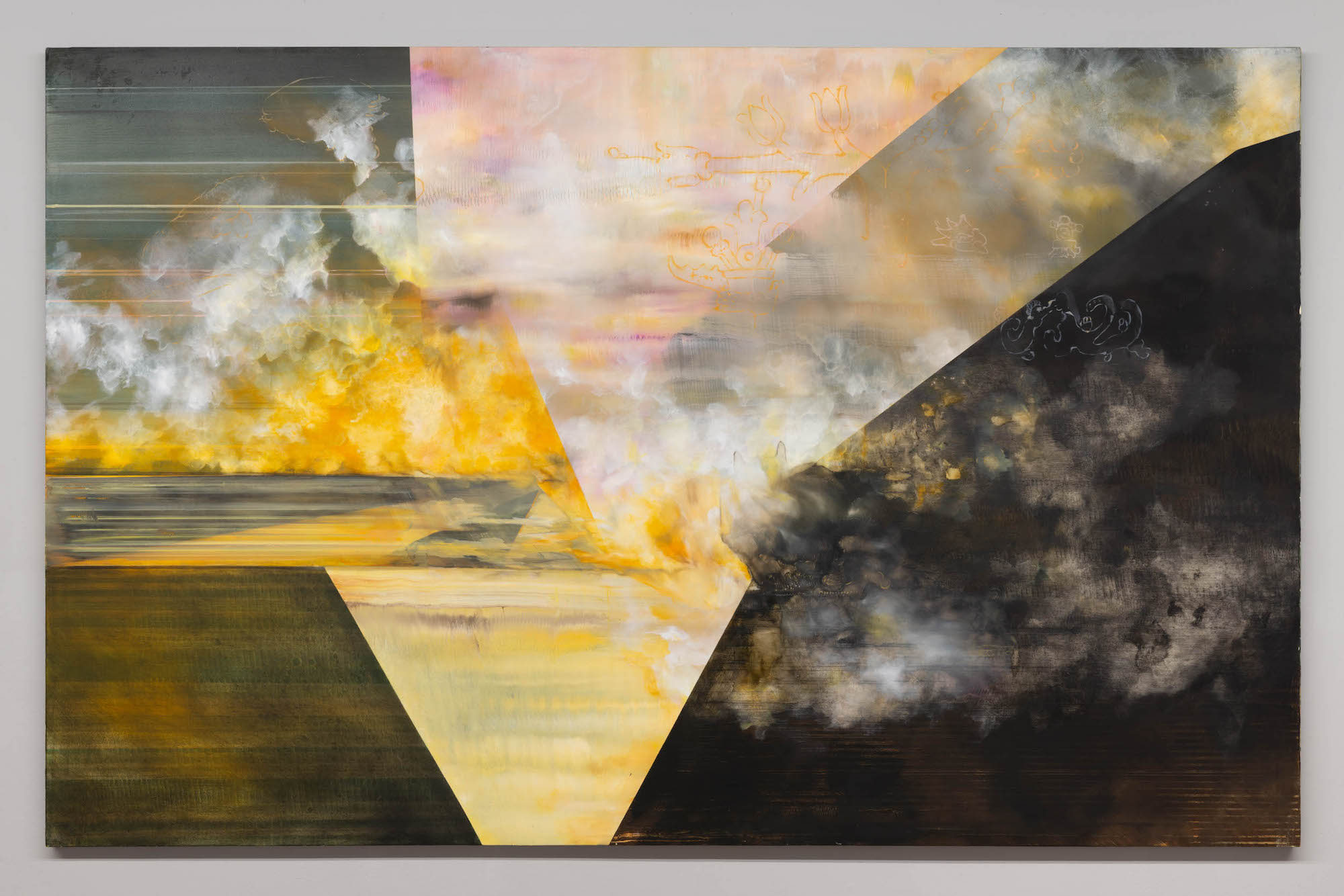
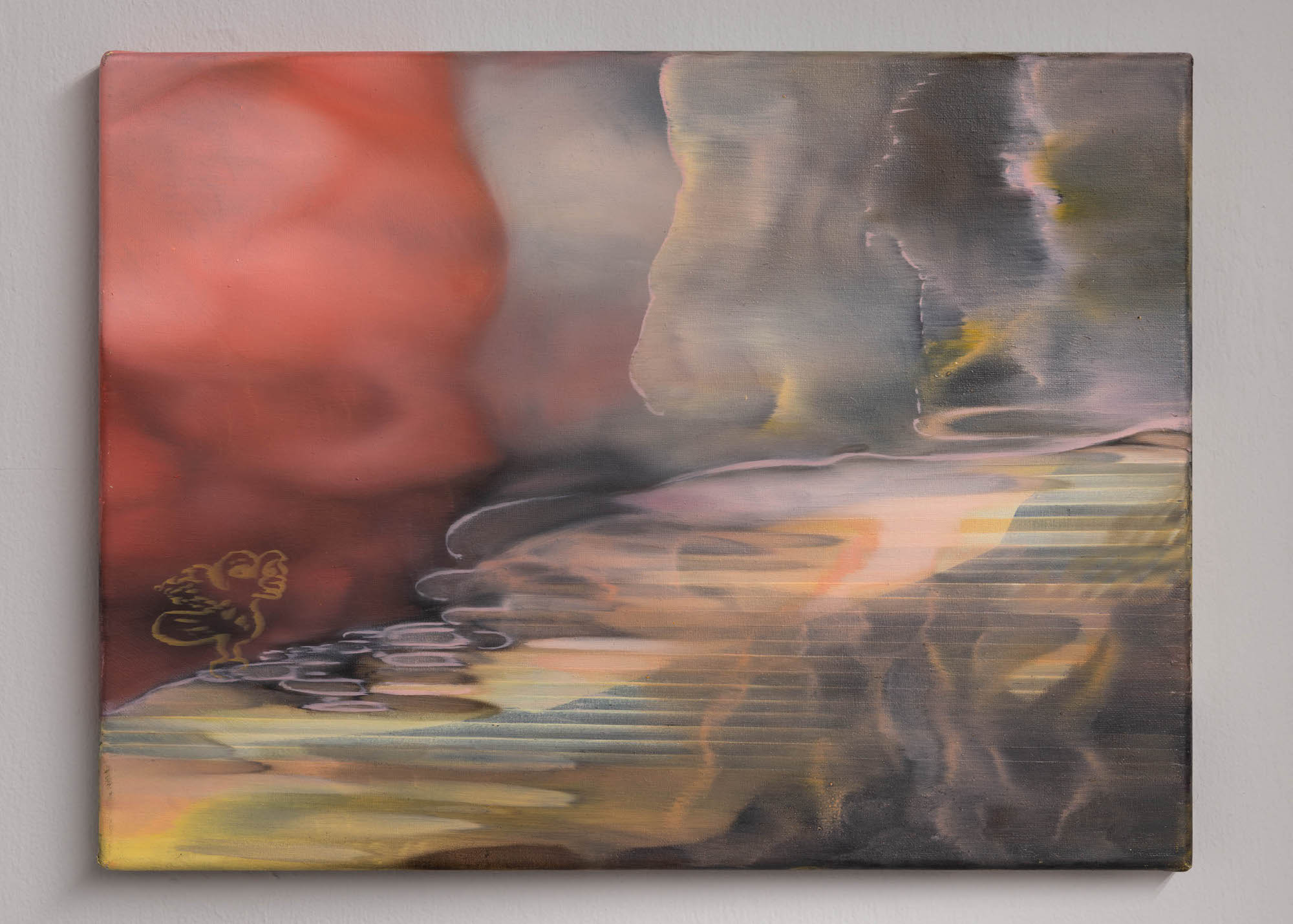
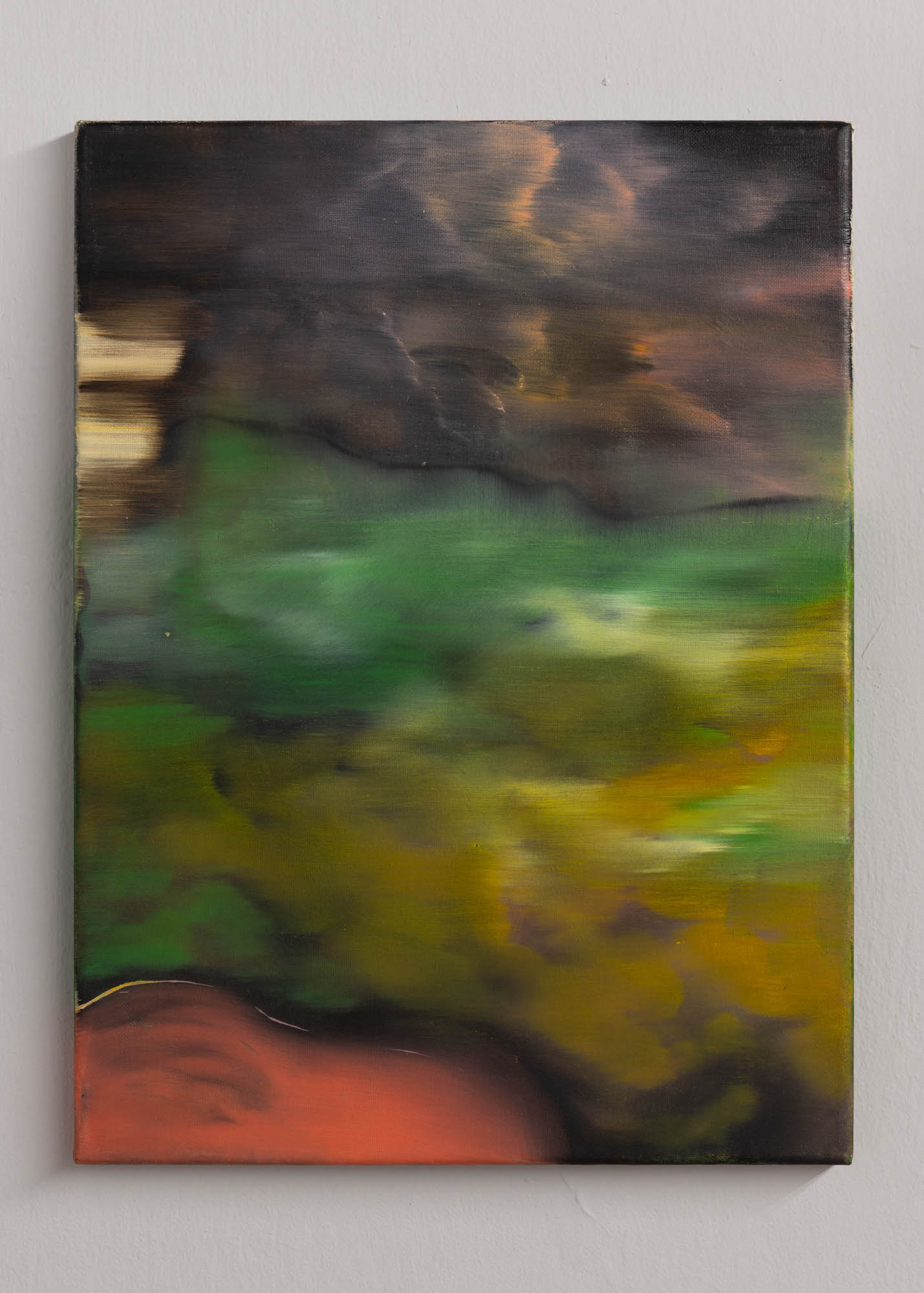
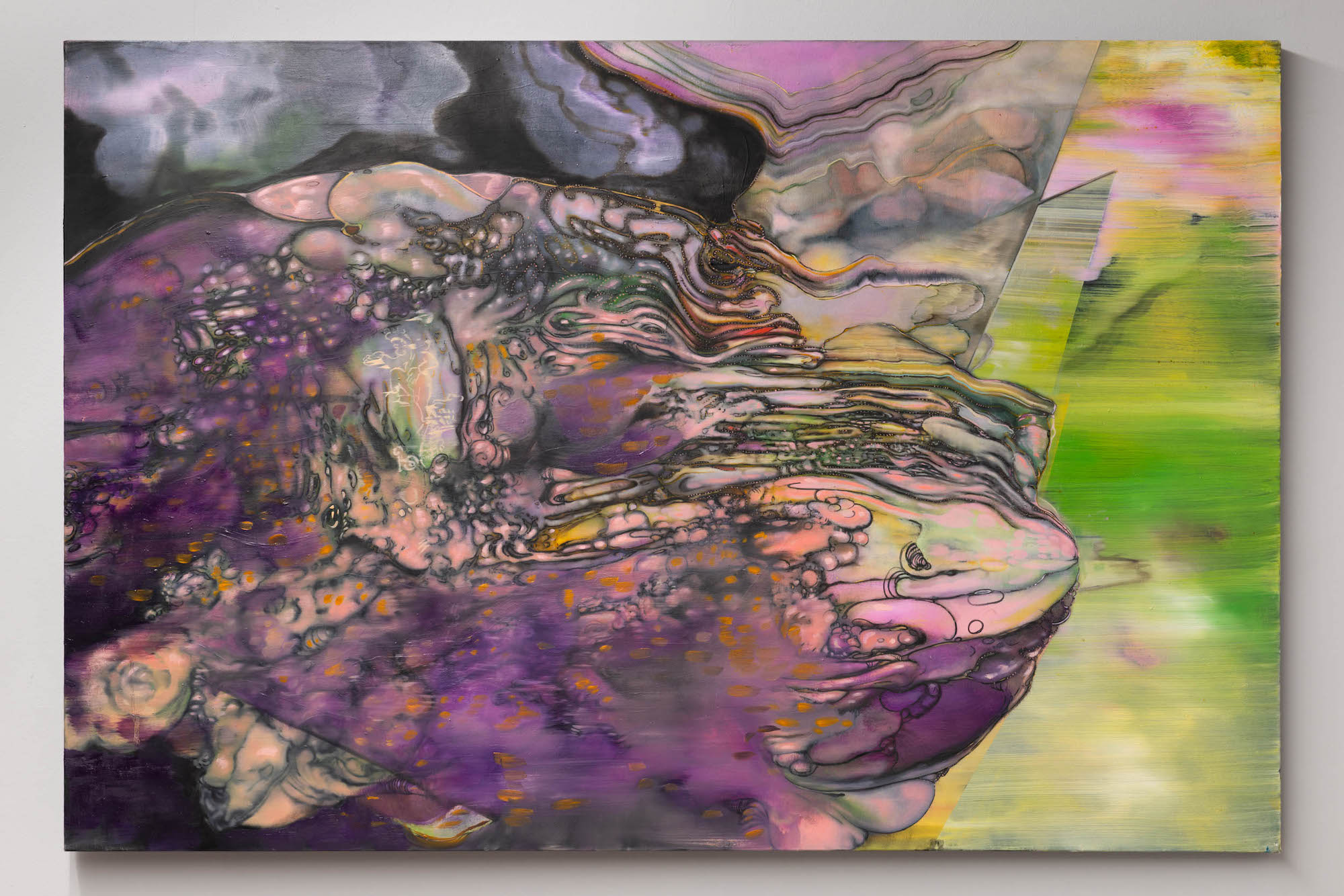
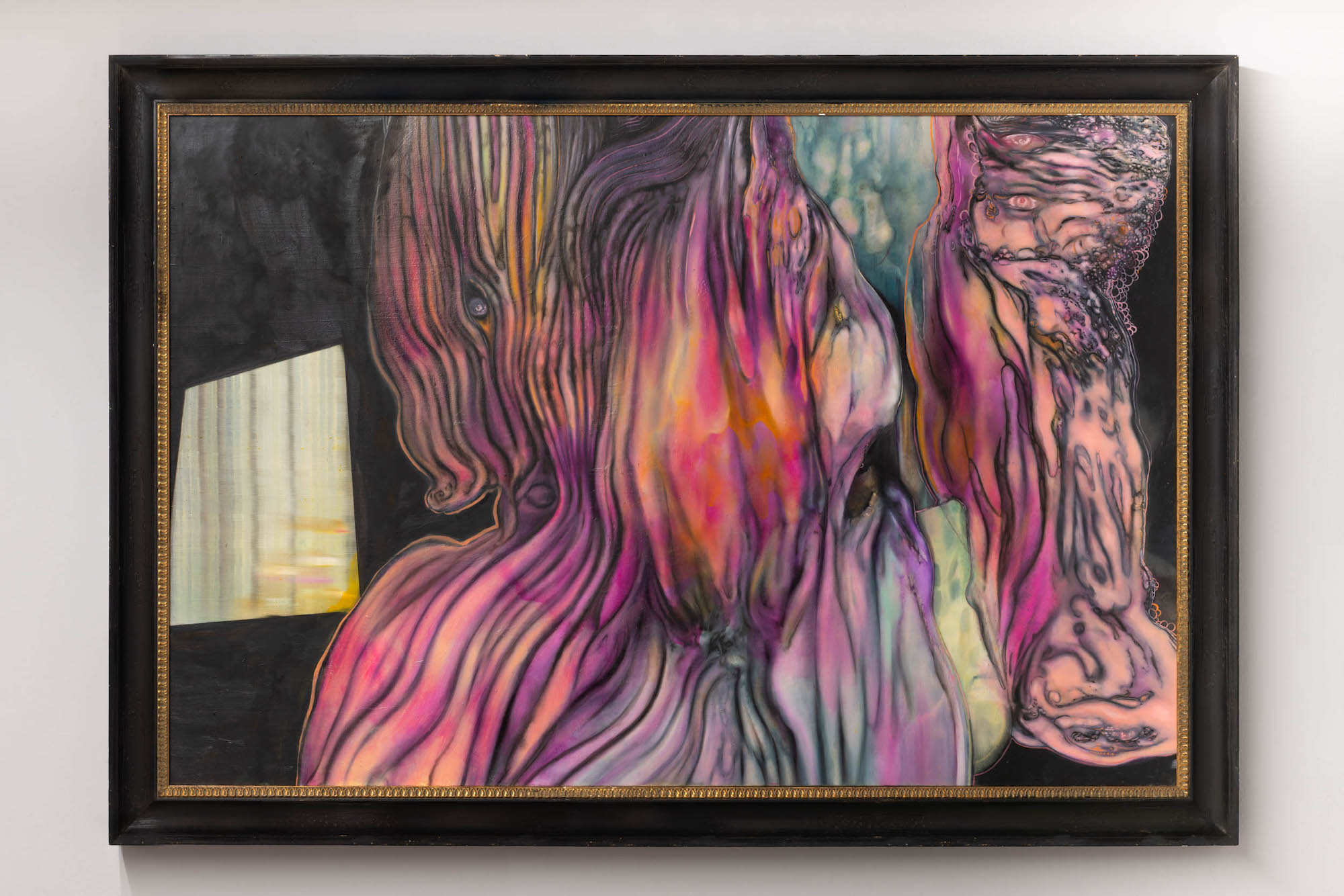
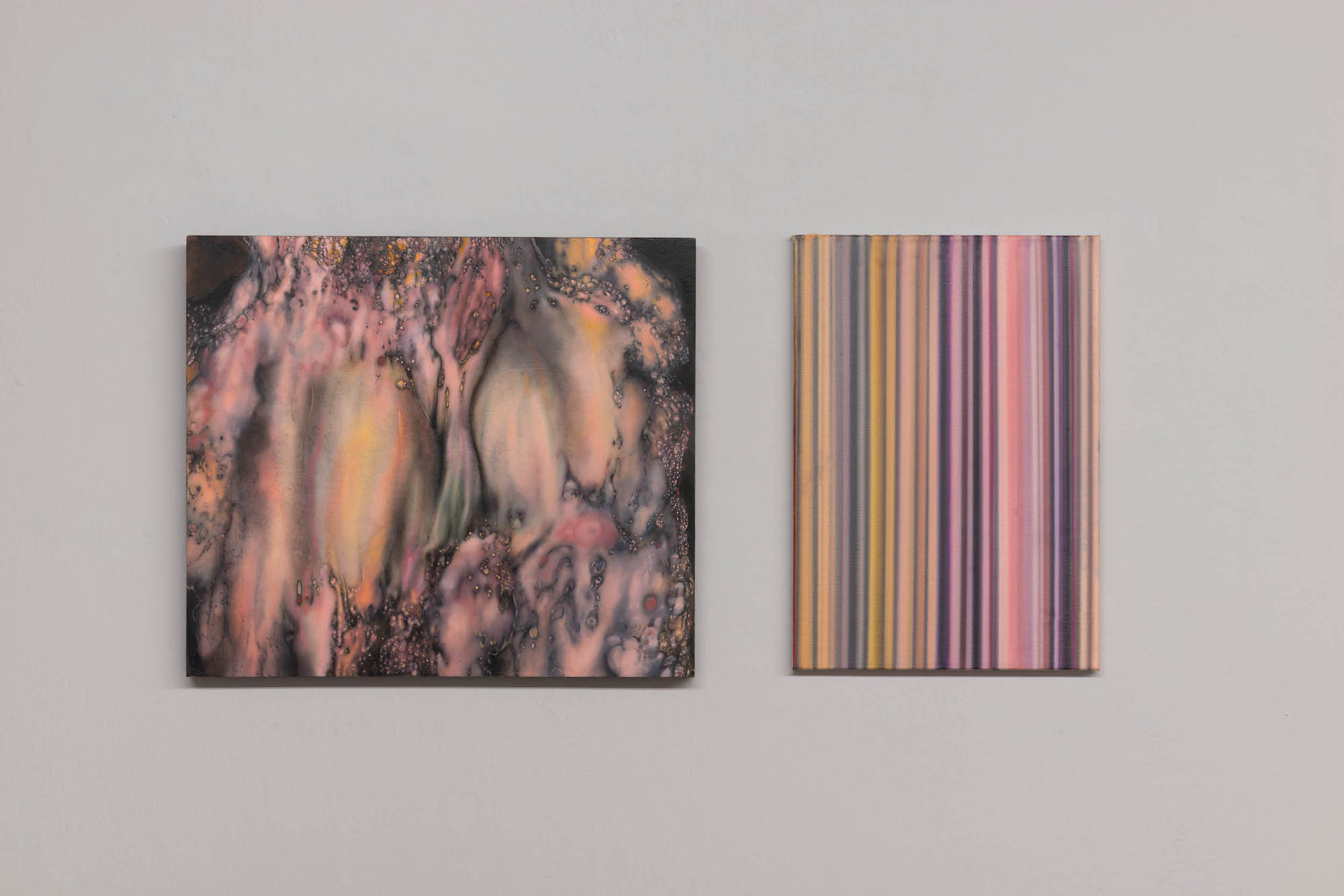
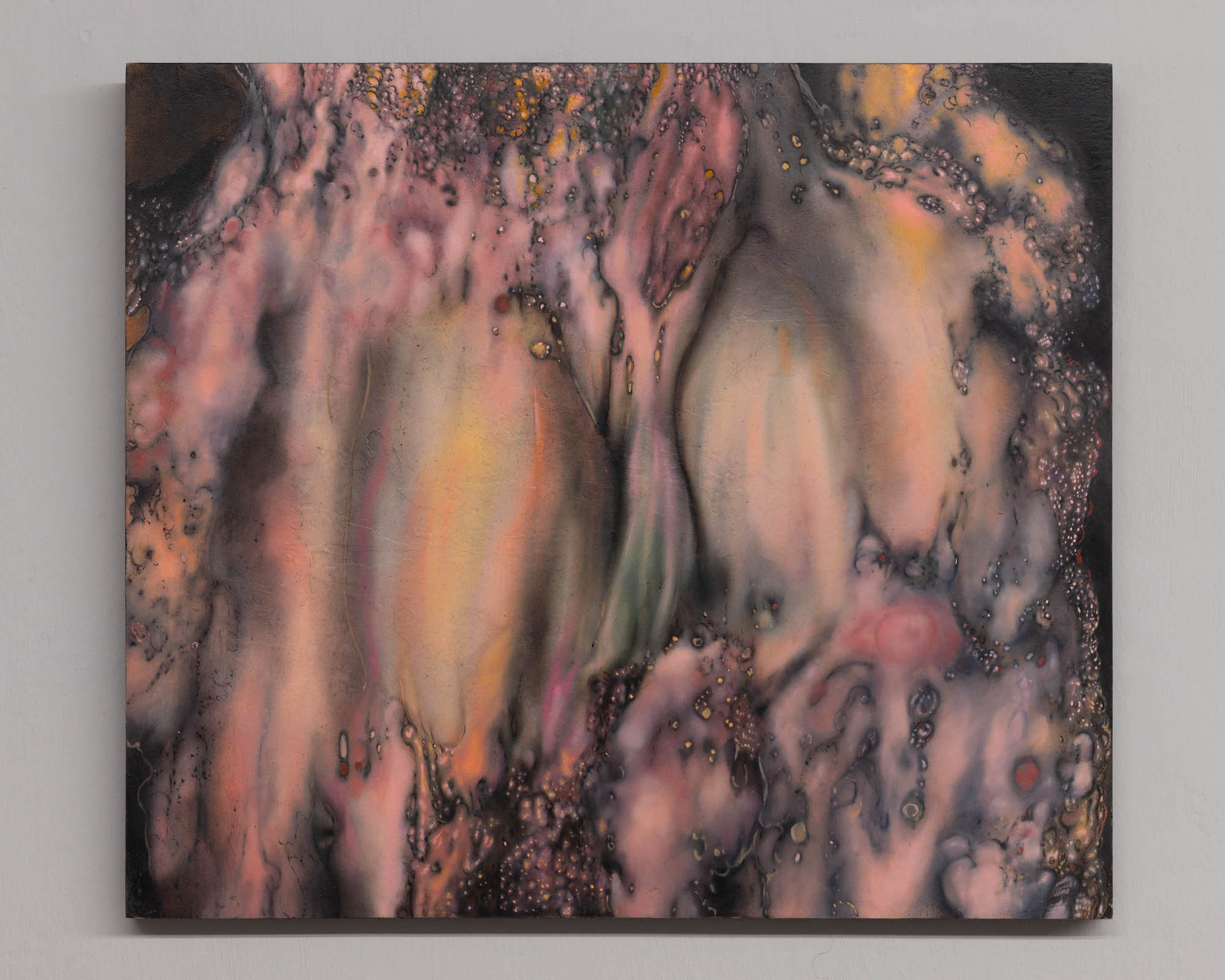
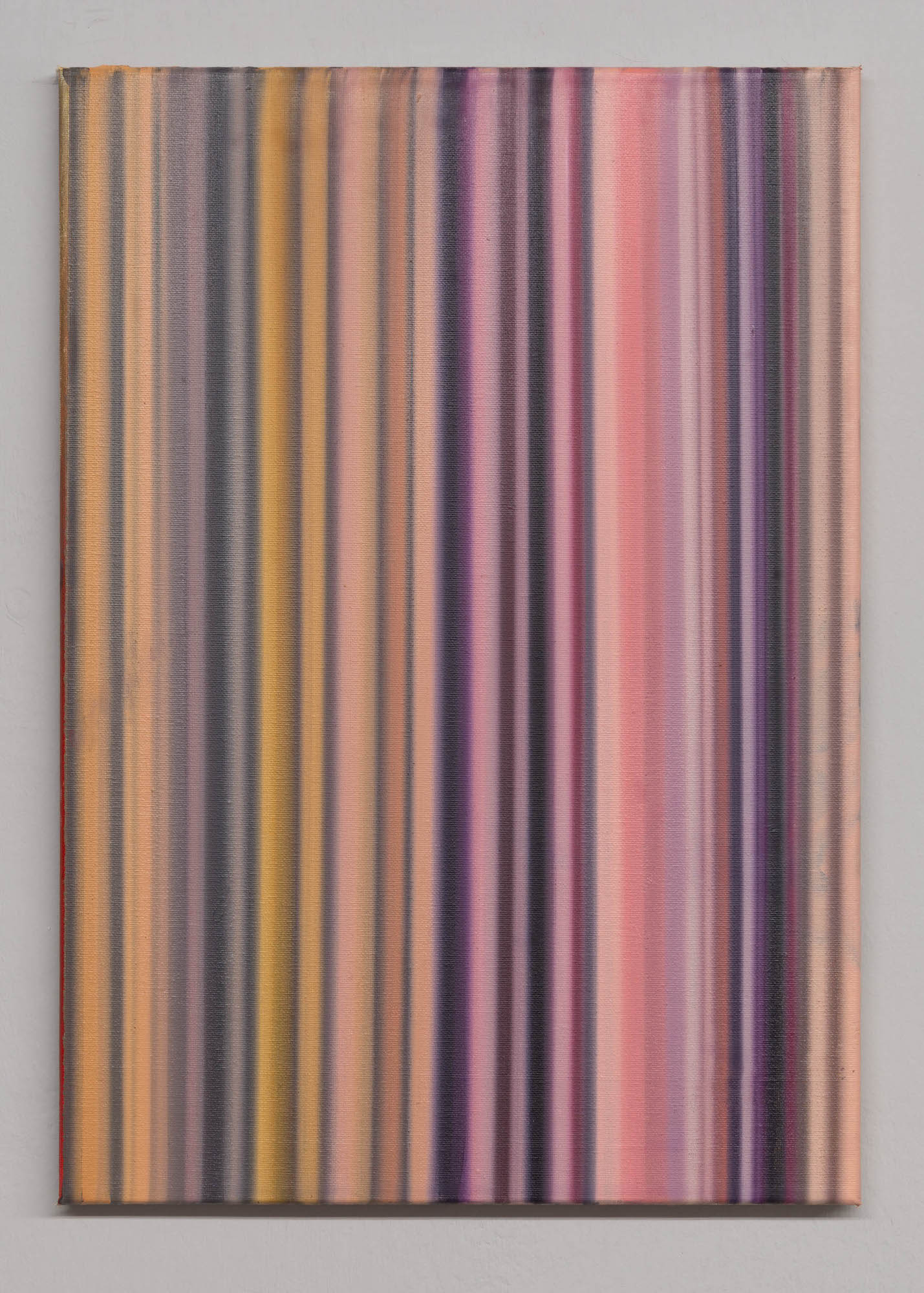
For all SMDOT/contemporary art exhibitions, a playlist will be created by Steve Nardini, the heart and soul of KOBO SHOP and a great musical expert. The following songs and artists have been selected for Marco Mendeni and his solo exhibition "rt_0.aletheia”